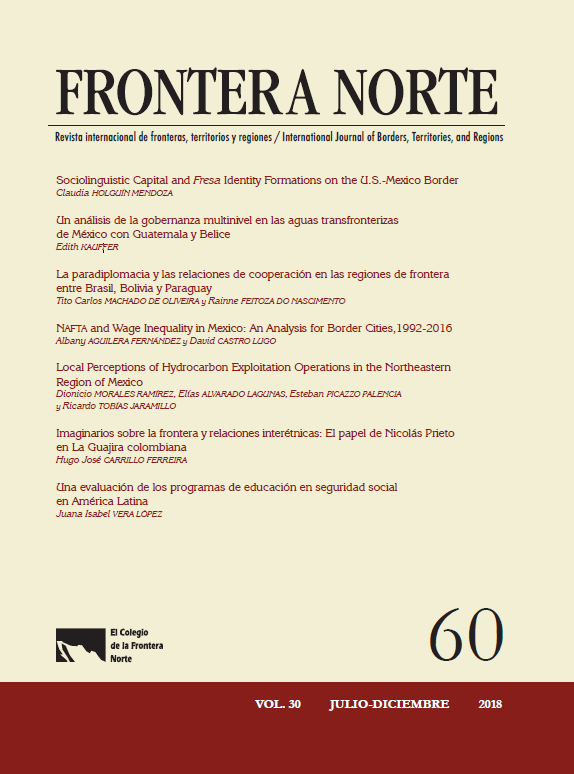Local Perceptions of Hydrocarbon Exploitation Operations in the Northeastern Region of Mexico
Main Article Content
Abstract
Article Details

This work is licensed under a Creative Commons Attribution-NonCommercial-NoDerivatives 4.0 International License.
Authors publishing work in this journal agree to the following conditions:
Authors retain copyright and assign first publication rights to the journal Frontera Norte (RFN), with the texts registered under an Attribution-NonCommercial-NoDerivatives 4.0 International Creative Commons license (CC BY-NC-ND 4.0), which allows third parties to use published material provided they give credit to the authors and acknowledge this journal as the first publisher.
They authorize the reproduction, publication, translation, communication, and transmission of their paper and all accompanying material, publicly and in any form and by any means; its public distribution in as many copies as required; and public communication thereof in any form, including making it available to the public through electronic means or any other technology, and solely for dissemination and scientific, cultural, and non-commercial purposes.
Authors may enter into further independent contractual agreements for the non-exclusive distribution of the version of the paper published in this journal (for instance, to include it in an institutional repository or personal webpage, or publish it in a book), provided it is not for commercial purposes and they clearly state that the work was first published in Frontera Norte (RFN) [and add the corresponding bibliographical record: Author/s (Year). Title of paper. Frontera Norte, volume (number), pp. doi: xxxx].
To that end, authors must submit the form assigning ownership of first publication rights, duly completed and signed. This document is to be uploaded in PDF format as a complementary file on the OJS platform.
This work is released under an Attribution-NonCommercial-NoDerivatives 4.0 International Creative Commons license (CC BY-NC-ND 4.0)..
References
Boudet, H., Clarke, C., Bugden, D., Maibach, E., Roser-Renouf, C., & Leiserowitz, A. (2014). “Fracking” controversy and communication: Using national survey data to understand public perceptions of hydraulic fracturing. Energy Policy, 65, 57-67. doi:10.1016/j.enpol.2013.10.017
Brown, R. B., Dorius, S. F., & Krannich, R. S. (2005). The Boom-Bust-Recovery cycle: Dynamics of Change in Community Satisfaction and Social Integration in Delta, Utah. Rural Sociology, 70(1), 28-49.
Centro de Investigaciones Sociales de la Universidad Autónoma de Tamaulipas. (2015). Reporte de diagnóstico general social (p. 141). México: Centro de Investigaciones Sociales de la Universidad Autónoma de Tamaulipas. Retrieved January 31, 2018, from http://www.impactosshalenoreste.uat.edu.mx/Docu-
ments/II.%20DIAGNÓSTICO-GENERAL-SOCIAL.pdf
Comisión Nacional de Hidrocarburos (CNH). (2015). Seguimiento a la exploración de aceite y gas de Lutitas. Mexico City: CNH. Retrieved July 19, 2017, from
Choma, B., Hanoch, Y., & Currie, S. (2016). Attitudes toward hydraulic fracturing: The opposing forces of political conservatism and basic knowledge about fracking. Global Environmental Change, 38, 108-117.
Davidson, D. (1979). Overview of the boomtown phenomenon and its effect on women and minorities. In U.S. Commission on Civil Rights, Energy Resource Development: Implications for Women and Minorities in the Intermountain West (pp. 15-25). Washington, D. C.: U.S. Government Printing Office.
Energy Information Administration (EIA). (2013). EIA/ARI World Shale Gas and Shale Oil Resource Assessment. Arlington, VA: EIA. Retrieved July 19, 2017, from https://www.adv-res.com/pdf/A_EIA_ARI_2013%20World%20Shale%20Gas%20and%20Shale%20Oil%20Resource%20Assessment.pdf
Instituto Nacional de Estadística y Geografía (Inegi). (2015). Censo de Población y Vivienda 2010. Mexico City: Inegi. Retrieved September 11, 2015, from http://www.inegi.org.mx/est/contenidos/proyectos/ccpv/cpv2010/default.aspx
International Energy Agency (IEA). (2014). Reporte de estadísticas. Retrieved May 11, 2015, from http://www.iea.org/stats/
Jacobsen, G., & Parker, D. (2014). The Economic Aftermath of Resource Booms: Evidence from Boomtowns in the American West. The Economic Journal,126(593), 1092-1128. doi: 10.1111/ecoj.12173
Jacquet, J. (2009). Energy Boomtowns and Natural Gas: Implications for Marcellus Shale Local Governments and Rural Communities (Working Paper No. 43). University Park, PA: Northeast Regional Center for Rural Development, Pennsylvania State University. Retrieved May 1, 2015, from http://aese.psu.edu/nercrd/publications/rdp/rdp43
Jacquet, J. (2012). Landowner Attitudes toward Natural Gas and Wind Farm Development in Northern Pennsylvania. Energy Policy, 50, 677-688.
Kohrs, E. V. (1974). Social Consequences of Boom Growth in Wyoming. Paper presented at the Rocky Mountain American Association of the Advancement of Science Meeting in Laramie, Wyoming. Pindedale, WY: Sublette County. Retrieved from http://www.sublettewyo.com/ArchiveCenter/ViewFile/Item/97
Morales, D., & Roux, R. (2015). Estudio de impacto social: Antecedentes y líneas base para San Fernando, Tamaulipas. Revista Internacional de Ciencias Sociales y Humanidades, 25(1), 111-130. Retrieved August 9, 2017, from http://revistasociotam.campuscemir.mx/ojssociotam/index.php/SOCIOTAM/article/view/424/405
Petróleos Mexicanos (Pemex). (2016). Base de datos institucional de Pemex: Pemex-exploración y producción. Producción de gas natural por región y activo. Mexico City: Pemex. Retrieved December 21, 2016, from http://ebdi.pemex.com/bdi/bdi-Controller.do?action=cuadro&subAction=applyOptions
Secretaría de Energía (Sener). (2014). Prospectiva del gas natural y gas LP 2014-2028. Mexico City: Sener. Retrieved May 16, 2016, from https://www.gob.mx/
cms/uploads/attachment/file/352/Prospectiva-GasNaturalGasLP-2014.pdf
Secretaría de Desarrollo Social (Sedesol). (2013). Microrregiones: Cédulas de información municipal. Mexico City: Sedesol. Retrieved May 18, 2015, from http://www.microrregiones.gob.mx/zap/default.aspx?entra=nación
Schafft, K. A., Borlu, Y., & Glenna, L. (2013). The Relationship between Marcellus Shale Gas Development in Pennsylvania and Local Perceptions of Risk and Opportunity. Rural Sociology, 78(1), 143-166.
Statistical package for the social sciences (SPSS) 19. New York, NY: IBM.
Theodori, G. (2012). Public Perception of the Natural Gas Industry: Data from the Barnett Shale. Energy Sources, Part B, 7(3), 275-281.
Theodori, G., & Jackson-Smith, D. (2010). Public Perception of the Oil and Gas Industry: The Good, the Bad, and the Ugly. Society of Petroleum Engineers. Retrieved May 18, 2015, from http://www.shsu.edu/glt002/documents/spe134253-TheodoriandJackson-Smith.pdf
Whitmarsh, L., Nash, N., Upham, P., Lloyd, A., Verdon, J., & Kendall, M. (2015). UK public perceptions of shale gas hydraulic fracturing: The role of audience, message and contextual factors on risk perceptions and policy support. Applied Energy, 160, 419-430.
Williams, L., Macnaghten, P., Davies, R., & Curtis, S. (2017). Framing ‘fracking’: Exploring public perceptions of hydraulic fracturing in the United Kingdom. Public Understanding of Science, 26(1), 89-104. doi:10.1177/0963662515595159

